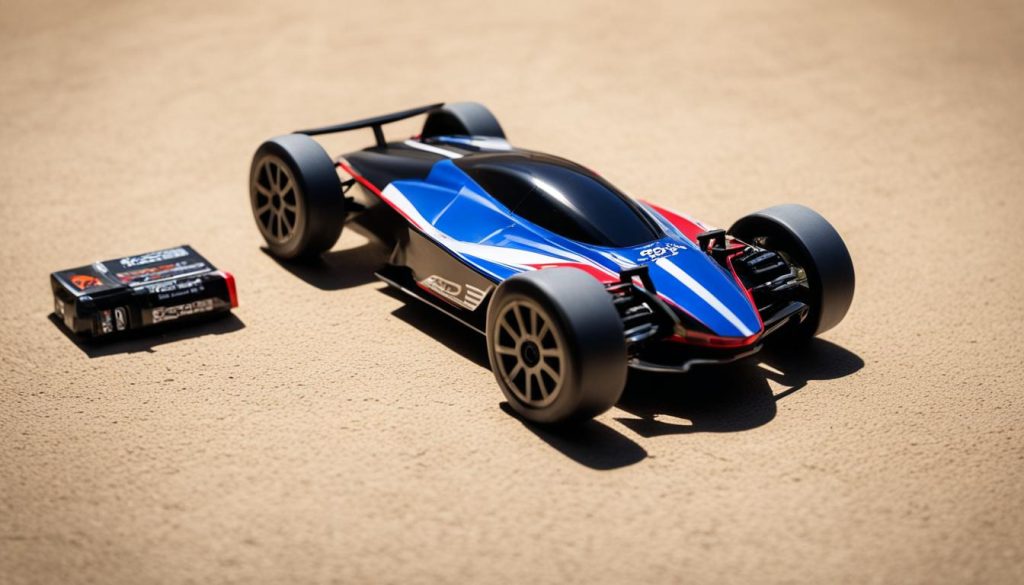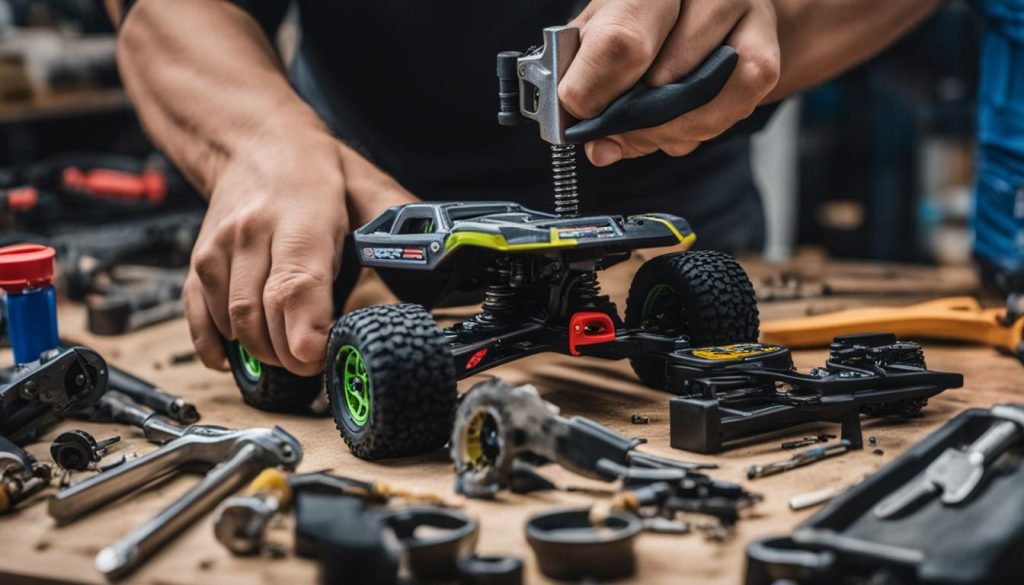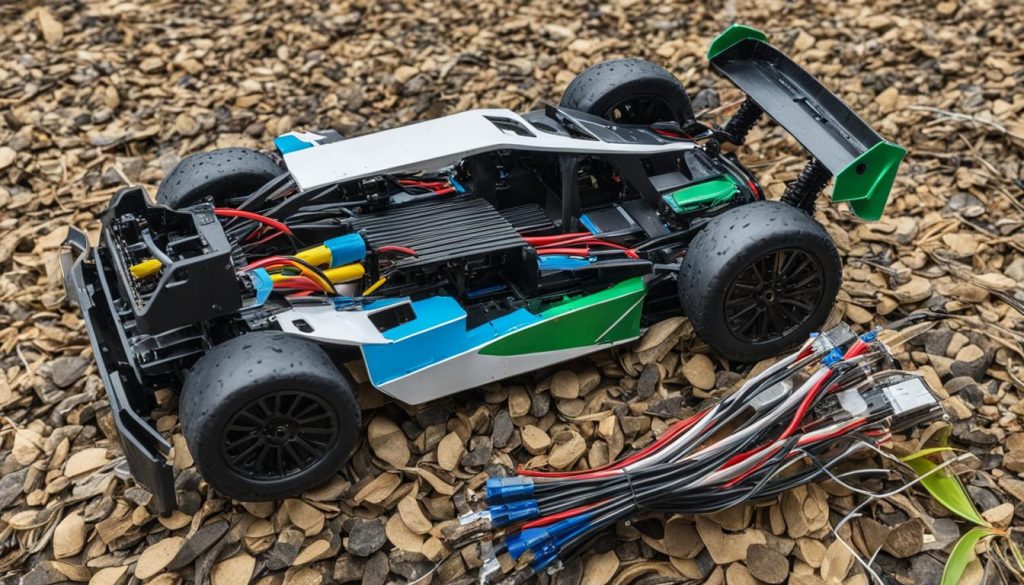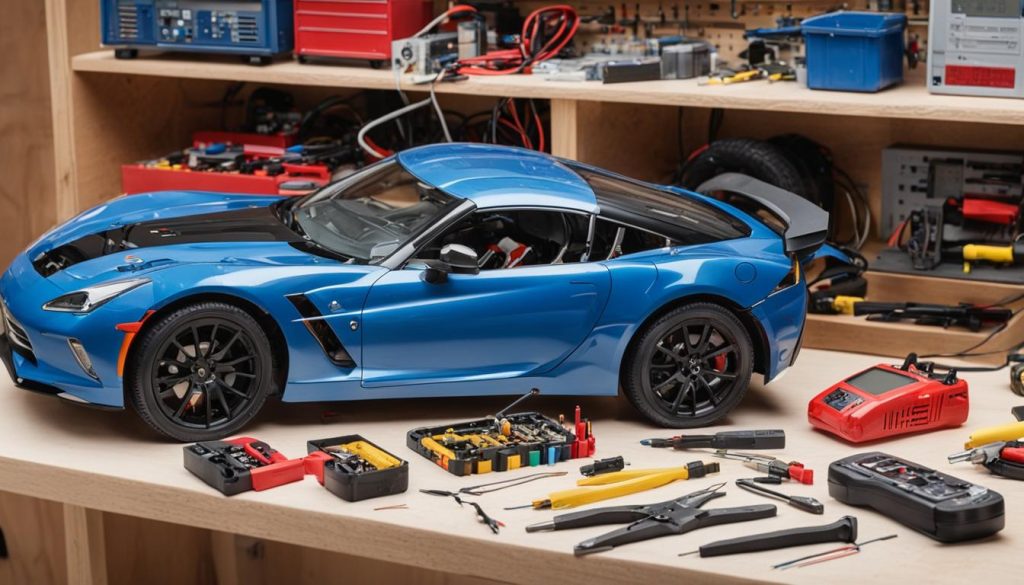When it comes to upgrading your RC car, one option that many enthusiasts consider is putting a bigger battery in a smaller car. But what happens if you take this route? In this article, we’ll explore the effects and consequences of using a larger battery in a smaller RC car. From maximizing performance to potential pitfalls, we’ll cover it all.
Key Takeaways:
- Upgrading your RC car’s battery can have a significant impact on its performance.
- Consider the compatibility and C rating of the new battery before making the switch.
- Make sure that your car’s ESC can handle the higher current draw.
- Choose a battery that matches the original voltage and consider the physical size of the new battery.
- Modifications may be necessary to accommodate the larger battery in a smaller RC car.
Understanding Battery C Rating
When upgrading the battery in your RC car, it’s essential to consider the battery’s C rating. The C rating refers to how much current the battery can deliver and charge in a given time. A higher C rating signifies a battery’s ability to deliver more power. For example, a 40C battery can provide twice the current of a 20C battery.
Choosing the right battery size and performance for a smaller RC car is vital to ensure compatibility and optimal performance. When upgrading the battery, it is recommended to select a battery with at least the same C rating as the original battery. By matching the C rating, you can prevent excessive stress on the battery during operation and maximize its performance.
“Choosing a battery with a lower C rating than the original may result in reduced power output and diminished performance.”
Battery C Rating Comparison:
| Battery | C Rating | Current Output |
|---|---|---|
| 20C Battery | 20C | Standard current output |
| 40C Battery | 40C | Twice the current output of a 20C battery |
| 60C Battery | 60C | Three times the current output of a 20C battery |
By choosing a battery with a higher C rating, you can provide more headroom for your RC car’s power needs. This can result in improved acceleration, increased top speed, and overall better performance. However, it’s crucial to ensure that other components in your RC car, like the ESC, can handle the higher current draw from the upgraded battery.
Next, let’s explore the role of the ESC in managing your RC car’s power system and how it can impact your battery upgrade decision.
The Role of ESC in Power System
The electronic speed controller (ESC) plays a crucial role in managing the power system of an RC car. It is responsible for connecting the battery to the motor and regulating the flow of power. When considering upgrading the battery in your RC car to a larger size, it’s important to understand the role of the ESC and its ability to handle increased power demands.
While a larger battery may offer the potential for increased power in smaller RC cars, it’s essential to ensure that the ESC can handle the higher current draw. If the ESC is not designed to handle the increased power, it may overheat or malfunction, leading to reduced performance and potential damage to the electronics.
An amp draw test can help determine the power requirements of your RC car’s system and whether the ESC has sufficient overhead to handle the larger battery. By measuring the current draw of the motor under maximum load, you can assess whether the ESC can handle the increased power without reaching its limits.
It’s crucial to remember that the ESC’s capabilities should match or exceed the power requirements of the larger battery. Upgrading the battery size without ensuring compatibility with the ESC can result in performance issues and potential damage to the power system.
Ensure that the ESC in your RC car is designed to handle the increased power demands of a larger battery by reviewing the manufacturer’s specifications and consulting with RC car enthusiasts or experts. By properly assessing and understanding the role of the ESC, you can make informed decisions when upgrading your RC car’s battery size, maximizing its power performance.
Battery Selection and Compatibility
When it comes to upgrading the battery in your RC car, selecting the right battery is essential for optimal performance. If you want to upgrade to a larger battery, there are a few factors to consider, such as voltage and capacity.
First and foremost, it’s important to choose a battery voltage that matches or closely matches the original battery. This is crucial to prevent compatibility issues and ensure that the upgraded battery works seamlessly with your RC car.
Additionally, you need to consider the physical size of the new battery. It should fit comfortably into your RC car without requiring any modifications. The last thing you want is to invest in a bigger battery only to find out that it doesn’t fit properly in your car’s battery compartment. So, double-check the dimensions before making a purchase.
To help you understand the importance of battery selection and compatibility, take a look at the following table:
| Battery | Voltage | Capacity | Physical Size |
|---|---|---|---|
| Original Battery | 7.4V | 3000mAh | 75mm x 40mm x 20mm |
| New Battery | 11.1V | 4000mAh | 85mm x 45mm x 25mm |
As you can see from the table, the new battery has a higher voltage and capacity. However, the physical size is slightly bigger as well. Before upgrading, make sure that the larger battery dimensions are compatible with your RC car.
To summarize, when selecting a new battery for your RC car, pay close attention to the voltage and capacity to ensure compatibility. Additionally, check the physical size of the battery to avoid any modification requirements. Now that you have a better understanding of battery selection and compatibility, you can make an informed decision when upgrading your RC car’s battery.
Voltage and Capacity Considerations
When upgrading the battery in your RC car, two essential factors to consider are voltage and capacity. These considerations play a significant role in the overall performance and functionality of your RC car.
Voltage:
The voltage of the battery should match the original battery or be compatible with your RC car’s power system. Using a larger battery with higher voltage can provide various benefits, including increased speed and power output. However, it’s crucial to ensure that your RC car’s power system can handle the higher voltage. Excessive voltage can strain the electronics and motors, leading to potential damage or decreased longevity.
Capacity:
The capacity of the battery is measured in milliamp-Hours (mAh) and determines how long your RC car can run between charges. Upgrading to a larger capacity battery offers the advantage of longer run times, allowing you to enjoy extended playtime without frequent recharging. However, larger capacity batteries may be physically larger as well. It’s essential to consider the available space in your RC car and ensure that the larger battery can fit without any modifications or complications.
Optimizing the voltage and capacity of your RC car’s battery when upgrading ensures that you can maximize its performance and enjoy long, uninterrupted play sessions. However, it’s crucial to strike the right balance to avoid any potential risks or adverse effects on your RC car’s components.
Modifying the RC Car
When it comes to upgrading your RC car’s battery, you may need to make some modifications to accommodate the larger size. It’s crucial to consider the available space in your car and find a suitable location for the new battery. This may involve removing or modifying certain parts, such as the battery bay or roll cage, to ensure a proper fit.
During the modification process, it’s important to exercise caution and avoid damaging any critical components of your RC car. Take your time and carefully assess the impact of the battery upgrade on the car’s overall structure and performance.
By taking the necessary steps to modify your RC car, you can safely and effectively install a larger battery and harness its increased power to enhance your driving experience.
Connecting the New Battery
Once you have chosen a larger battery for your RC car, the next step is to connect it to the power system. This process requires careful attention to ensure a secure and efficient connection.
Start by soldering wires to the appropriate battery terminals, taking care not to hinder the installation of the original batteries if needed. The soldered connections should be strong and reliable, providing a stable electrical connection.
When connecting the new battery, it is recommended to use appropriate connectors to prevent short circuits and ensure proper electrical connections. These connectors can simplify the process and allow for easy removal and replacement of the battery when necessary.
After connecting the new battery, it’s essential to test the performance of your RC car. This will help you gauge the impact of the larger battery and ensure everything is functioning as expected. Look out for any noticeable changes in speed, power, or overall performance.
Remember, proper battery connection is crucial for the safe and optimal operation of your RC car, so take the time to double-check all connections and ensure they are secure before enjoying your upgraded RC car.
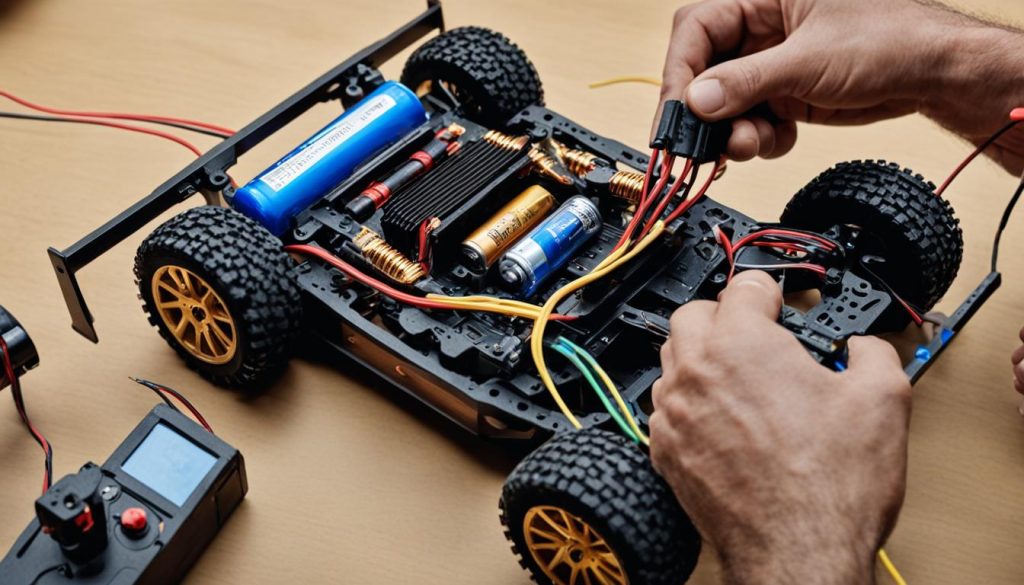
Battery Connection Checklist
| Steps | Description |
|---|---|
| Step 1 | Solder wires to battery terminals |
| Step 2 | Use appropriate connectors for secure connections |
| Step 3 | Test the performance of the RC car |
Performance Effects of a Bigger Battery
Upgrading to a bigger battery in a smaller RC car can have significant effects on its performance. By increasing the voltage, the larger battery can deliver more power to the car’s motor, resulting in increased speed and overall performance. With the higher voltage, you can maximize the performance of your RC car and have a more thrilling and exhilarating driving experience.
“By upgrading to a larger battery, you can unlock the full potential of your RC car and push it to higher speeds.”
However, it’s important to note that using a larger battery can also put additional stress on the car’s electronics and motors. The increased power draw may cause the components to work harder, potentially leading to overheating or premature wear and tear. Regular monitoring and maintenance are crucial to ensure the longevity of your RC car.
Weighing the Pros and Cons
When considering a RC car battery upgrade and using a larger battery in a smaller RC car, it’s important to weigh the pros and cons. Let’s take a closer look at the effects of using a larger battery in a smaller RC car.
One of the main benefits of using a bigger battery is the potential for increased power and performance. With a larger battery, you can experience higher speeds and more significant power output, enhancing your overall driving experience.
However, it’s crucial to consider the potential drawbacks as well. Putting a bigger battery in a smaller RC car can have an impact on the car’s components, such as the motor lifespan and heat management. The higher voltage and increased power may put additional strain on the motors, potentially shortening their lifespan. It’s important to monitor the car’s electronics and motors for signs of excessive stress or overheating.
Ultimately, the decision to upgrade to a larger battery in a smaller RC car depends on your specific needs and preferences. Weighing the pros and cons can help you make an informed choice that aligns with your desired performance and the longevity of your RC car.
Pros of using a larger battery in a smaller RC car:
- Increased power and performance
- Higher speeds and more significant power output
- Enhanced driving experience
Cons of using a larger battery in a smaller RC car:
- Potential impact on motor lifespan
- Possible heat management challenges
- Excessive stress on the car’s components
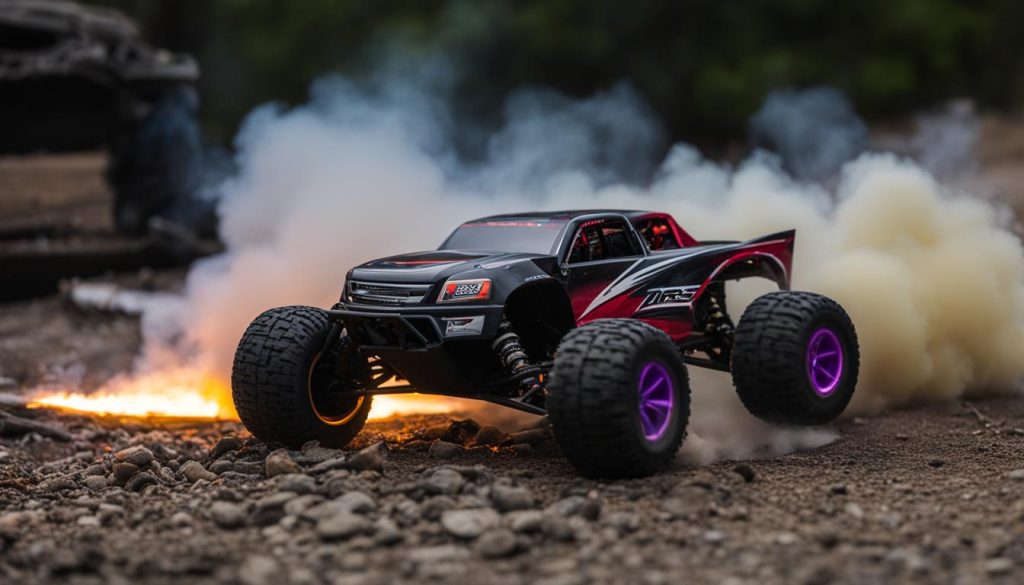
| Pros | Cons |
|---|---|
| Increased power and performance | Potential impact on motor lifespan |
| Higher speeds and more significant power output | Possible heat management challenges |
| Enhanced driving experience | Excessive stress on the car’s components |
Safety Considerations
When upgrading your RC car’s battery, safety should always be your top priority. Modifying or installing a larger battery requires careful attention to prevent any potential risks or hazards. Here are some important safety considerations to keep in mind:
- Ensure Proper Insulation and Connection: When connecting the new battery, make sure to insulate and secure all wires properly. This helps prevent the risk of short circuits or electrical issues that could damage your RC car or pose a safety hazard.
- Monitor Temperature: Regularly monitor your RC car’s temperature during operation, especially when using a larger battery. Higher power output may generate more heat, so it’s important to prevent overheating. If you notice any unusual behavior or excessive heat, stop using the RC car immediately and investigate the issue further.
Expert Insight:
“Maintaining a safe operating temperature is essential for the longevity and performance of your RC car. Regularly check the temperature of your battery, motors, and electronic components during and after use to ensure they are within the recommended operating range.”
– RC Car Enthusiast
By following these safety considerations, you can enjoy the benefits of a larger battery upgrade in your RC car while minimizing the potential risks. Remember, always prioritize safety when working with any modifications or upgrades to your RC car’s battery system.
| Safety Tips for RC Car Battery Upgrade |
|---|
| Ensure proper insulation and connection of wires. |
| Monitor the temperature to prevent overheating. |
Conclusion
Upgrading the battery in a smaller RC car by using a larger battery can have a significant impact on its performance. By increasing the voltage and power potential, you can enhance the speed and power output of your RC car. However, it is vital to consider several factors before making this upgrade.
Firstly, ensure that the larger battery is compatible with your RC car in terms of size and voltage. Choose a battery that closely matches or is compatible with the original battery to prevent any compatibility issues or damage to your car’s power system.
Additionally, consider the capabilities of your Electronic Speed Controller (ESC). A larger battery may draw more current, so it is crucial to ensure that your ESC can handle the increased power demand without overheating or causing any damage.
Lastly, keep in mind that using a larger battery might impact the lifespan of your motors. The higher voltage and power output can put more stress on the motors, potentially shortening their lifespan. Regular maintenance and monitoring of your RC car’s performance will help you detect any signs of excessive stress or overheating, allowing you to address them promptly.
By carefully evaluating these factors and prioritizing safety, you can make an informed decision about upgrading your RC car’s battery. With the right battery choice, proper modifications, and careful monitoring, you can maximize the performance of your smaller RC car and enjoy an enhanced driving experience.
FAQ
What happens if you put a bigger battery in a smaller RC car?
Putting a bigger battery in a smaller RC car can have noticeable effects on its performance, such as increased speed and power output. However, it is important to consider factors like battery compatibility, ESC capability, and potential impacts on motor lifespan.
Why is the C rating of the battery important?
The C rating of a battery determines its ability to deliver and charge current. When upgrading the battery in a smaller RC car, it is recommended to choose a battery with at least the same C rating as the original battery to prevent excessive stress on the battery during operation.
What role does the ESC play in an RC car’s power system?
The ESC (electronic speed controller) manages the power system of an RC car. While a larger battery may offer increased power potential, it is essential to ensure that the ESC can handle the higher current draw. An amp draw test can help determine the system’s power requirements and whether the ESC has sufficient capacity for the larger battery.
How do I select the right battery for my RC car?
When selecting a new battery for your RC car, consider factors such as voltage and capacity. Choose a battery voltage that matches or closely matches the original battery to prevent compatibility issues. Additionally, ensure that the physical size of the new battery will fit in the RC car without requiring modifications.
What should I consider regarding voltage and capacity when choosing a new battery?
Voltage should match the original battery or be compatible with the car’s power system. Capacity, measured in milliamp-Hours (mAh), determines the runtime of the car between charges. Larger capacity batteries offer longer run times but may be physically larger. Consider the available space in the RC car when selecting a higher capacity battery.
Do I need to modify my RC car to install a larger battery?
When installing a larger battery in a smaller RC car, some modifications may be necessary. Consider the available space in the car and identify a suitable location for the new battery. It may be necessary to remove or modify certain parts of the car, such as the battery bay or roll cage, to accommodate the larger battery. Take caution not to damage any critical components during the modification process.
How do I connect the new battery to the power system of my RC car?
Connecting the new battery involves soldering wires to the appropriate battery terminals, ensuring they do not hinder the installation of the original batteries if needed. It is recommended to use appropriate connectors to prevent short circuits and ensure proper electrical connections. Once the new battery is connected, test the performance of the RC car to gauge the impact of the larger battery.
What are the performance effects of using a larger battery in a smaller RC car?
Upgrading to a bigger battery in a smaller RC car can increase speed and overall power. The higher voltage provided by the larger battery enhances performance. However, it is necessary to monitor the car’s electronics and motors for signs of excessive stress or overheating. Additionally, the higher voltage may shorten the lifespan of the motors, so regular maintenance and monitoring are important.
What are the pros and cons of putting a bigger battery in a smaller RC car?
The benefits of using a larger battery in a smaller RC car include increased power and performance, allowing for higher speeds and greater power output. However, there are potential drawbacks, such as impacts on motor lifespan and heat management. Weighing the pros and cons can help determine if a battery upgrade is worth it for your specific RC car.
What safety considerations should I keep in mind when upgrading the battery in my RC car?
Safety should be a top priority when modifying or upgrading an RC car’s battery. Insulate and connect wires properly to prevent short circuits. Monitor the car’s temperature during operation to prevent overheating. If any unusual behavior or excessive heat is detected, stop using the RC car and investigate the issue further.
What should I consider when upgrading the battery in my RC car?
When upgrading the battery in your RC car, consider factors such as battery compatibility, ESC capability, voltage, capacity, performance effects, and safety considerations. By carefully evaluating these aspects, you can make an informed decision about the battery upgrade.
Source Links
- https://www.rcuniverse.com/forum/mrc-charger-product-support-i-e-super-brain-etc-478/11694919-can-i-use-higher-mah-batteries.html
- https://www.rcgroups.com/forums/showthread.php?1832563-Can-someone-explain-how-higher-Mah-batteries-make-a-car-faster
- https://www.instructables.com/Cheap-RC-Car-Battery-Upgrade/

